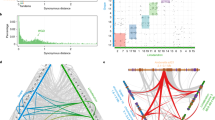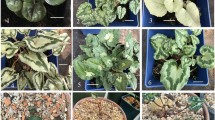Abstract
The evolutionary pattern of the myc-like anthocyanin regulatory gene antR-Cor was examined in the dwarf dogwood species complex (Cornus Subgenus Arctocrania) that contains two diploid species (C. canadensis and C. suecica), their putative hybrids with intermediate phenotypes, and a tetraploid derivative (C. unalaschkensis). Full-length sequences of this gene (∼4 kb) were sequenced and characterized for 47 dwarf dogwood samples representing all taxa categories from 43 sites in the Pacific Northwest. Analysis of nucleotide diversity indicated departures from neutral evolution, due most likely to local population structure. Neighbor-joining and haplotype network analyses show that sequences from the tetraploid and diploid intermediates are much more strongly diverged from C. suecica than from C. canadensis, and that the intermediate phenotypes may represent an ancestral group to C. canadensis rather than interspecific hybrids. Seven amino acid mutations that are potentially linked to myc-like anthocyanin regulatory gene function correlate with petal colors differences that characterize the divergence between two diploid species and the tetraploid species in this complex. The evidence provides a working hypothesis for testing the role of the gene in speciation and its link to the petal coloration. Sequencing and analysis of additional nuclear genes will be necessary to resolve questions about the evolution of the dwarf dogwood complex.
Similar content being viewed by others
References
Atchley WR, Wollenberg KR, Fitch WM, Terhalle W, Dress AW (2000) Correlation among amino acid sites in bHLH protein domains: an information theoretic analysis. Mol Biol Evol 17:164–178
Bain JF, Denford KE (1979) The herbaceous members of genus Cornus in NW North America. Bot Notiser 132:121–129
Carroll SB (1995) Homeotic genes and the evolution of arthropods and chordates. Naturalist 376:479–485
Clay SN, Hath J (1971) Cytogenetics of some species of Cornus. Cytologia 36:716–730
Clement M, Posada D, Crandall KA (2000) TCS: a computer program to estimate gene genealogies. Mol Ecol 9:1657–1659
Consonni G, Viotti A, Dellaporta SL, Tonelli C (1992) cDNA nucleotide sequence of Sn, a regulatory gene in maize. Nucleic Acids Res 20:373
Consonni G, Geuna F, Gavazzi G, Tonelli C (1993) Molecular homology among members of the R gene family from maize. Plant J 3:335–346
Dermen H (1932) Cytological studies of Cornus. J Arnold Arboretum 13:410–417
De-Vetten N, Quattrocchio F, Mol J, Koes R (1997) The an1 locus controlling flower pigmentation in Petunia encodes a novel WD-repeat protein conserved in yeast, plants, and animals. Genes Dev 11:1422–1434
Dickinson WJ (1988) On the architecture of regulatory systems: evolutionary insights and implications. BioEssays 8:204–208
Doebley J (1993) Genetics, development and plant evolution. Curr Opin Genet Dev 3:865–872
Doebley J, Lukens L (1998) Transcriptional regulators and the evolution of plant form. Plant Cell 10:1075–1082
Fan C, Xiang Q-Y (2001) Phylogenetic relationships within Cornus L. (Cornaceae) based on 26S rDNA sequences. Am J Bot 88:1131–1138
Fan C, Purugganan MD, Thomas DT, Wiegmann BM, Xiang Q-Y (2004) Heterogeneous evolution of the myc-like anthocyanin regulatory gene and its phylogenetic utility in Cornus L. (Cornaceae). Mol Phylogen Evol 33:580–594
Felsenstein J (1985) Confidence limits on phylogenies: an approach using the bootstrap. Evolution 39:783–791
Felsenstein J (2004) Inferring phylogenies. Sinauer, Sunderland, MA
Ferris S, Whitt G (1979) Evolution of the differential regulation of duplicate genes after polyploidization. J Mol Evol 12:367–317
Fu YX, Li WH (1993) Statistical tests of neutrality of mutations. Genetics 133:693–709
Goldsbourougn AP, Tong Y, Yoder JI (1996) Lc as a non-destructive visual reporter and transposition marker gene for tomato. Plant J 9:927–933
Gong Z, Yamagishi E, Yamazaki M, Saito K (1999) A constitutively expressed myc-like gene involved anthocyanin biosynthesis from Perilla frutescens: molecular characterization, heterologous expression in transgenic plants and transactivation in yeast cells. Plant Mol Biol 41:33–44
Goodrich J, Carpenter R, Coen ES (1992) A common gene regulates pigmentation pattern in diverse plant species. Cell 68:955–964
Gunatilleke CVS, Gunatilleke AUN (1984) Some observations on the reproductive biology of three species of Cornus (Cornaceae). J Arn Arb 65:419–427
Hu J, Anderson B, Wessler SR (1996) Isolation and characterization of rice R genes: evidence for distinct evolutionary paths in rice and maize. Genetics 142:1021–1031
Kellogg EA (2002) Root hairs, trichomes and the evolution of duplicate genes. Trends Plant Sci 6:550–552
King JL, Wilson AC (1975) Evolution at two levels in humans and chimpanzees. Science 188:107–116
Levine M, Tjian R (2003) Transcription regulation and animal diversity. Nature 424:147–151
Lewonton RC, Birch LC (1966) Hybridization as a source of variation for adaptation to new environments. Evolution 20:315–336
Lioyd AM, Walbot V, Davis RW (1992) Arabidopsis and Nicotiana anthocyanin production activated by maize regulators R and C1. Science 258:1773–1775
Ludwig S, Wessler SR (1990) Maize R gene family: tissue-specific helix-loop-helix proteins. Cell 62:849–852
Martin C, Prescott A, Mackay S, Barlett J, Vrijlandt E (1991) Control of anthocyanin biosynthesis in flower of Antirrhinum majus. Plant J 1:37–49
Mol J, Grotewold E, Koes R (1998) How genes paint flowers and seeds. Trends Plant Sci 3:212–217
Moore RC, Purugganan MD (2005) The evolutionary dynamics of plant duplicate genes. Curr Opin Plant Biol 8:122–128
Murrell ZE (1994) Dwarf dogwoods: intermediacy and the morphological landscape. Syst Bot 19:539–556
Nei M (1987) Molecular evolutionary genetics. Columbia University Press, New York, USA
Palopoli MF, Patel N (1996) Neo-Darwinian developmental evolution- can we bridge the gap between pattern and process?. Curr Opin Genet Dev 6:502–508
Papp B, Pál C, Hurst LD (2003) Evolution of cis-regulatory elements in duplicated genes of yeast. Trends Genet 19:417–422
Purugganan MD (1998) The molecular evolution of development. BioEssays 20:700–711
Purugganan MD (2000) The molecular population genetics of regulatory genes. Mol Ecol 9:1451–1461
Purugganan MD, Suddith JI (1998) Molecular population genetics of the Arabidopsis CAULIFLOWER regulatory gene: nonneutral evolution and naturally occurring variation in floral homeotic function. Proc Natl Acad Sci USA 95:8130–8134
Purugganan MD, Suddith JI (1999) Molecular population genetics of floral homeotic loci: departures from the equilibrium-neutral model at the APETALA3 and PISTILLATA genes of Arabidopsis thaliana. Genetics 151:839–848
Quattrocchio F, Wing JF, Leppen HTC, Mol JNM, Koes RE (1993) Regulatory genes controlling anthocyanin pigmentation are functionally conversed among plant species and have distinct sets of target genes. Plant Cell 5:1497–1512
Quattrocchio F, Wing JF, Woude KVD, Mol JNM, Koes RE (1998) Analysis of bHLH and MYB domain proteins: species-specific regulatory differences are caused by divergent evolution of target anthocyanin genes. Plant J 13:475–488
Radicella PD, Turks D, Chandler VL (1991) Cloning and nucleotide sequence of a cDNA encoding B-Peru, a regulatory protein of the anthocyanin pathway in maize. Plant Mol Biol 17:127–130
Riechmann JL, Meyerowitz EM (1997) MADS domain proteins in plant development. Biol Chem 378:1079–1101
Rozas J, Sánchez-Delbarrio JC, Messeguer X, Rozas R (2003) DNASP, DNA polymorphism analyses by the coalescent and other methods. Bioinformatics 19:2496–2497
Simpson P (2002) Evolution of development in closely related species of flies and worms. Nature Rev Genet 3:907–917
Stapleton A (1992) ultraviolet radiation and plants: burning questions. Plant Cell 4:1353–1358
Swofford DL (2002) PAUP: phylogenetic analysis using parsimony, version 4.0b10. Sinauer Associates, Sunderland, MA
Tajima F (1989) Statistical methods for testing the neutral mutation hypothesis by DNA polymorphism. Genetics 123:595–595
Taylor RL, Brockman RP (1966) Chromosome numbers of some western Canadian plants. Can J Bot 44:1093–1103
Templeton AR, Crandall KA, Sing CF (1992) A cladistic analysis of phenotypic associations with haplotypes inferred from restriction endonuclease mapping and DNA sequence data. III Cladogram estimation. Genetics 132:619–633
Thompson JD, Gibson TJ, Plewniak F, Jeanmougin F, Higgins DG (1997) The Clustal X windows interface: flexible strategies for multiple sequence alignment aided by quality analysis tools. Nucleic Acids Res 24:4876–4882
Watterson G (1975) On the number of segregating sites in genetical models without recombination. Theor Popul Biol 7:256–276
Wendel JF (2000) Genome evolution in polyploids. Plant Mol Biol 42:225–249
Wilson AC (1975) Evolutionary importance of gene regulation. Stadler Symposium vol 7. University of Missouri, Columbia, Missouri, pp 117–134
Wolfe KH (2001) Yesterday’s polyploids and the mystery of diploidization. Nat Rev Genet 2:333–341
Xiang QY, Soltis DE, Soltis PS (1998) Phylogenetic relationships of Cornaceae and close relatives inferred from matK and rbcL sequences. Am J Bot 85:285–297
Xiang Q-Y(J), Thomas DT, Zhang WH, Manchester SR, Murrell Z (2006) Species level phylogeny of the Dogwood genus Cornus (Cornaceae) based on molecular and morphological evidence – implication in taxonomy and Tertiary intercontinental migration. Taxon 55:9–30
Acknowledgments
The authors thank the following people for their help with the study: Brian Cassel for assistance with sequencing; Jingen (Jim) Qi, Christian Brochmann, Margaret Ptacek, and Jean Schulenberg for plant sample collection; Nina Gardner for DNA extraction and morphological identification; members of the Xiang lab for a variety of help and discussion; Becky Boston for using her lab space in the experiments; and, Tom Wentworth and two anonymous reviewers for critically reading the manuscript. This study is supported by Faculty Research Grants from Idaho State University and North Carolina State University and NSF grant DEB-0129069 to Q.-Y.X., and Karling Graduate Student Research Award from Botanical Society of America and Deep Gene Travel Award from Deep Gene Research Coordination Network (NSF DEB-0090227 funded to B. D. Mishler) to C.F.
Author information
Authors and Affiliations
Corresponding author
Rights and permissions
About this article
Cite this article
Fan, C., Xiang, QY.(., Remington, D.L. et al. Evolutionary patterns in the antR-Cor gene in the dwarf dogwood complex (Cornus, Cornaceae). Genetica 130, 19–34 (2007). https://doi.org/10.1007/s10709-006-0016-3
Received:
Accepted:
Published:
Issue Date:
DOI: https://doi.org/10.1007/s10709-006-0016-3




